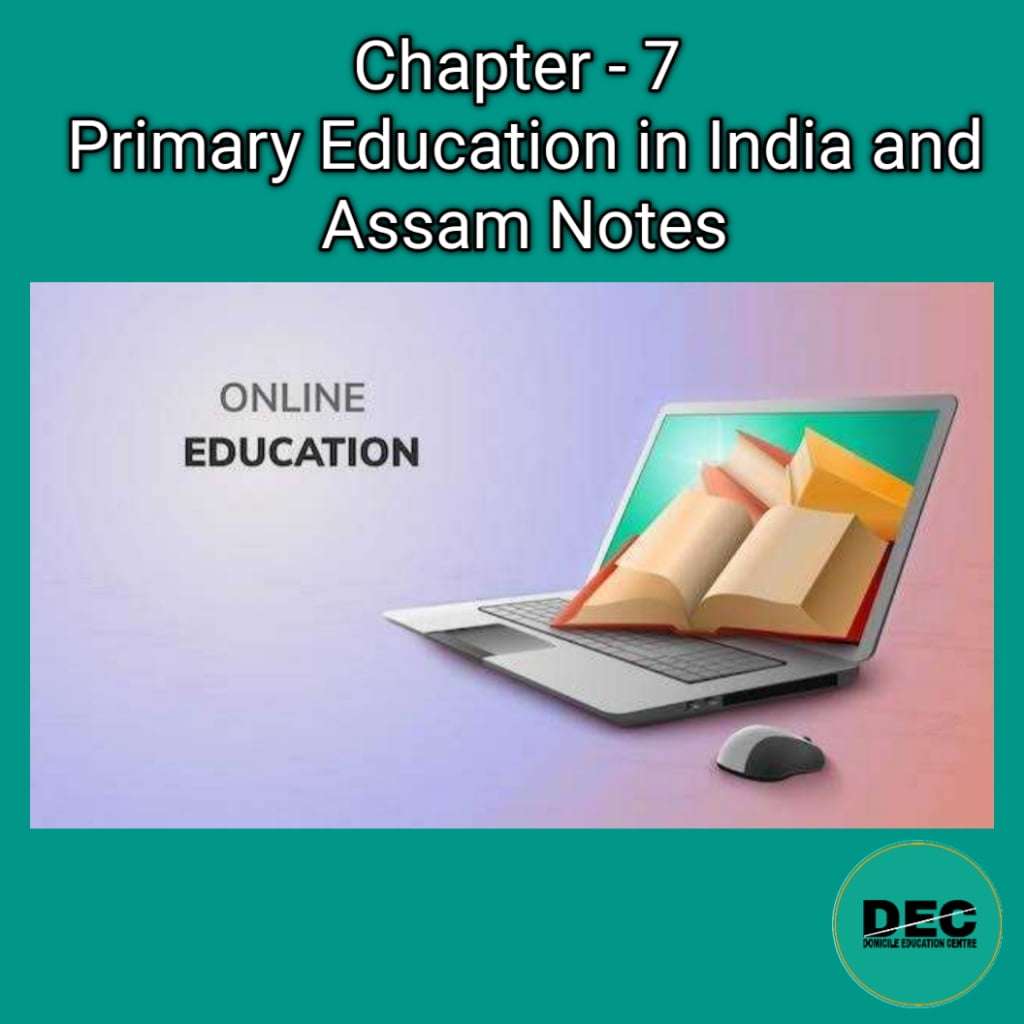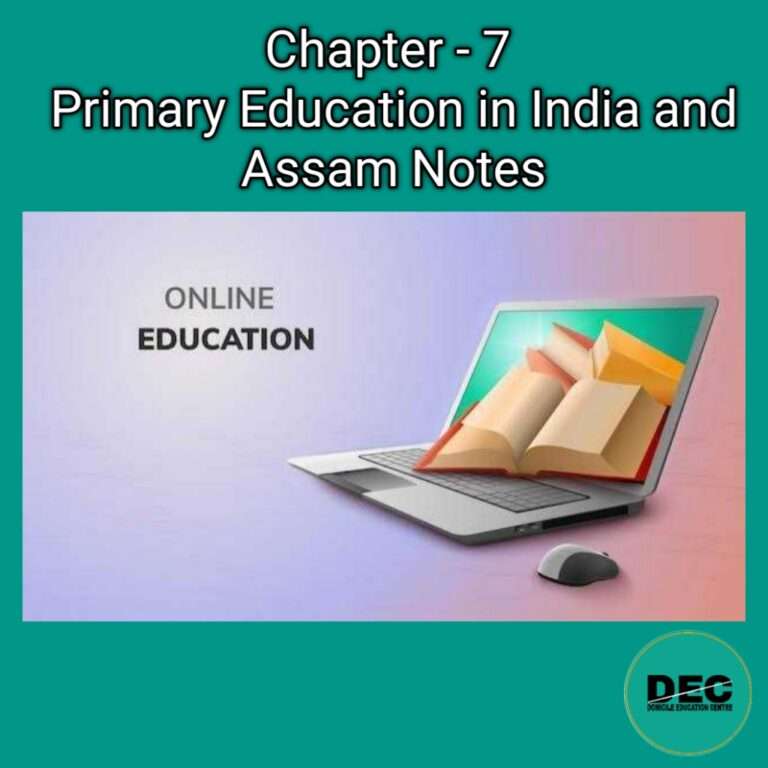Chapter-7 | Primary Education in India and Assam | Notes
The chapter of Primary Education in India and Assam is to acquaint the nature of the development of primary education in the country during the pre-independent period comprising the government and non-government enterprises which are:
- Indigenous Education System such as: Gurukul system, Pathsala, Tols, Satras, Maqtabs, Madrassas, Monitorial system.
- Contribution of Missionary in madras, Calcutta, and Bombay.
- Contribution of Missionaries in Assam.
- The charter Act of 1813.
- Anglicist Classicist Controversy and Macaulay’s Minute.
1. What are different types of Indigenous educational institution?
Ans: The indigenous educational institution are mentioned below:
i. Gurukul system.
ii. Pathsala’s.
iii. Tol’s.
iv. Satra’s.
v. Maktab’s.
vi. Madrassa’s.
vii. Monitorial system.
Gurukul system:
Gurukul system of education is one of the Vedic system of indigenous educational institution where the students used to attain formal education in his guru’s (teacher) house is known as Gurukul system. In Gurukul system, the Guru or the teacher used to organize, control and manage all the affairs of this education like- food and living place of the students. Here, Both poor and rich family were sent to the Guru’s house to attain formal education and students was also like the son of the Guru in this institution. The study of the subjects under the Guru includes- Vedas, philosophy, mathematics, economics, astronomy, astrology and grammar, etc. The method of instruction was verbal recitation and disciplinary was based on the principle of self realization through self discipline.
Pathsala:
Popular institution of indigenous education for the Hindus are the Pathsala which was used to give religious education through classical language by the Pandits. The medium of instruction was Sanskrit and method of teaching was verbal. The chief objectives of the Pathsala was to create the pandits in the society who might undertake intellectual activity. The subjects of this institution was includes –language study, grammar, arithmetic, social studies, moral lesion, accountancy, etc. for satisfaction of the socio-economic needs of people.
Tol’s:
Tol’s are also known as Sanskrit schools which was established during the Zamindari system in the society to spread Sanskrit education. It is the special institution of higher education of the Hindus that can be compared to that of the colleges at present. The duration of the course usually was six to eight years and it was the centre of free education. Tol’s are still fairly numerous in Assam, Bengal, Bihar and Uttar Pradesh. Famous Sanskrit Tol’s were established at Banaras, Kashi, Ujjain and Mithila in ancient India. The medium of instruction was Sanskrit and subjects includes Vedas along with religion, art, mathematics and science were taught.
Satra’s:
Satra is one of special indigenous social institution in Assam which is known as ‘Satra institution’. ‘Satra’s are the greatest contribution of Sankar deva and his active spiritual life to fulfil the needs of the general masses. Vaona- Sabha , dramatic performance, classical dances are the main features of the cultural activities of the Satra’s. Regularly the ‘Satra’ celebrates Sri Krishna Duel Utsav, Rash Jutra, etc. and people are united through these functions.
Satra institution contributed immensely to the spread of education of Art and culture. They are Kamala Bari Satra, Garmur satra, Patbausi satra, Auniati satra, Bengena Ati satra, Paneri satra, etc. Satra’s are the treasury of Assmamese as well as Mahapurusia (Vaishnava) Art and Culture. Satra’s are still working as centres of cultural training in devotional songs and dance popularly known as “Straiya Nritya Geet”.
Maktab:
Maktab is the chief institution for primary education of Islamic faith. The term ‘Maktab’ has been derived from Arabic word ‘Qutab’ which means a place where reading and writing was attached to the mosque as a part of religious activity. The aim of education was to teach the pupil knowledge of the Alphabet and religious prayer and to give elementary knowledge of reading and sometimes to write a Arabic and Persian. The system of admission to the Maktab was special in nature and the centre point of education was Maulabi of the mosque to take charge of education as his religious responsibility to give special attention for the correctness of pronunciation by the ‘Maulabi’.
Methods of education was verbal that gives more importance to rote memory and system of education was manged by the royal authority. Some of rich people appoint private teacher to educate their children in their house.
Madrassa:
Madrassa is the higher educational institution of the indigenous system of education. On completion of elementary education students were given to entre here. This type of institution are generally attached to Mosque or Masjid. The word ‘Madrassa’ has been derived from Arabic word ‘Darash’ which means ‘deliver lecture’. The curriculum was more comprehensive that covered academic, practical and science subjects. The subjects of study were mainly related to Islamic religion like- Arabic, grammar, literature, logic, philosophy, law, astrology, history, geography, medicine, agriculture, etc. to create an intellectual class of people in the Muslim community. There was no formal ceremony of admission in Madrassa and the course of study was for ten years duration which was managed by the private managing body.
2. Short Note on 'Monitorial System or Bell System.
Ans: In the indigenous system of Vedic and Muslim education, there was the process of teaching the junior students in the absence of the teacher. It was later known as Monitorial system. Here, the teacher or the Guru used to engage his favourite students to teach in order to minimize his work load of teaching.
During the British rule in India a Christian Missionary Dr. Andrew Bell, the superintendent of Orphan boys charity school was introduced this system to spread of education and religion in the state of Madras in the later half of the 18th century. After his name it was called ‘Bell system or Bell pratha’. Presently, this system of teaching continues in our society particularly in single teacher school.
3.Write briefly about 'Serampore-Trio'.
Ans: ‘Serampore-Trio was a unit of Christian missionaries. The Baptist Mission Society spread Christianity as well as education in the different places of Bengal. The main Baptist missionaries were William Ward who was the press compositor, William Carey was the religious preacher and Joshua Marshman was the school teacher. They were called ‘Serampore-Trio.
They were came to Bengal from the ‘Trencober of Madras and selected a village named ‘Serampore’ at a distance of about 13 miles towards the north of Calcutta as their centre to develop the missionary activities and established several schools for boys and girls at Serampore.
Archives
4. Short Note on The Charter Act of 1813.
Ans: Unser the situation created by Charles Grants ‘observations’ the Charter of the East India Company came up for renewal in the British Parliament in 1813.
This Act was passed under section 43 had stated ‘ a sum of not less than one lakh of rupees should be annually set apart by the company and applied for the revival and improvement of literature and science among the learned of India’.
This was the first official document which sanctioned a big sum of rupees for the cause of education in the country. Its major implication was to create an agency that may spend one lakhs of rupees for education of the people in British India.
Importance of the Charter Act of 1813:
The Act of 1813 appears to be historically a landmark on several points of consideration. These are:
(i) The British administration in India had for the first time realised its educational responsibility with the Act of 1813.
(ii) It had sanctioned a big sum of rupees for the first to serve the cause of Indian education.
(iii) Accordingly one lakh of rupees were proposed to be set a part for sending annually.
(iv) The British administration had realised that they had the official responsibility to remove poverty and illiteracy of the Indian people.
(v) The company was also legally held responsible for educational development in the country.
(vi) The way to western literature and culture in India was opened up by the Act of 1813.
(vii) The later educational and political developments in British India owe their origin to this charter act of 1813.
5. Short Note on Anglicist-Classicist Controversy.
Ans: At that time, there was no Education Department under the government to decide the issues. There was the General Committee of Public Instruction formed only in 1823 consisted of 10 members who were equally divided in their opinion.
In the General Committee, there were the Orientalist group and Anglicist group. The Orientalist group supporting the cause of native Indian Classical languages (headed by H.T. Princeps, Lord Minto, Warrant Hastings and H.H Wilson) and Anglicist group of members supporting the cause of English language and literature. These two controversial group of the General Committee are known as the Anglicist-Classicist controversy.
This Act had naturally made the people in India more conscious of their education and culture. Major factors involved in Anglicist and Anglicist controversy and its resultant out are mentioned below:
(i) Four different agencies were undertaking responsibility of Indian education at the time of controversy. They were:
(a) Christian missionaries.
(b) Pundits and Maulabies of Classical groups.
(c) Oriental Englishmen, knowing Sanskrit and Arabic.
(d) Young British administration supporting English education and culture.
(ii) Provision of the Charter Act of 1813, themselves were quite vague that had given rise to controversy.
(iii) The major points of controversy were:
(a) On aims of education.
(b) On medium of Instruction.
(c) On agency of education
(d) On method to be adopted in giving education.
(iv) Members of the General Committee of Public Instruction were equally divided.
(v) Lord Macaulay, the chairman of the committee was in support of English language and culture.
(vi) Macaulay submitted his report in favour of the Anglicist on 2nd February, 1835.





Recent Comments